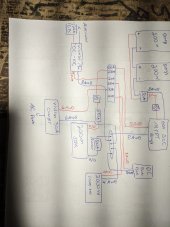SpiritualRhino
New Member
- Joined
- May 27, 2021
- Messages
- 4
Hi all. After much research I have settled on this preliminary diagram for my build in a Nissan NV 2500. I know I have some more things to consider such as the length of the wires. I plan to have all the components in a box of sorts so the things that need to be close together will be. But as far as lines to the alternator or to the panels I may need different size wires as I figure that out. Just looking for some confirmation from people with experience that these pieces should work together in this way without issue.
Thanks for your time
Thanks for your time





